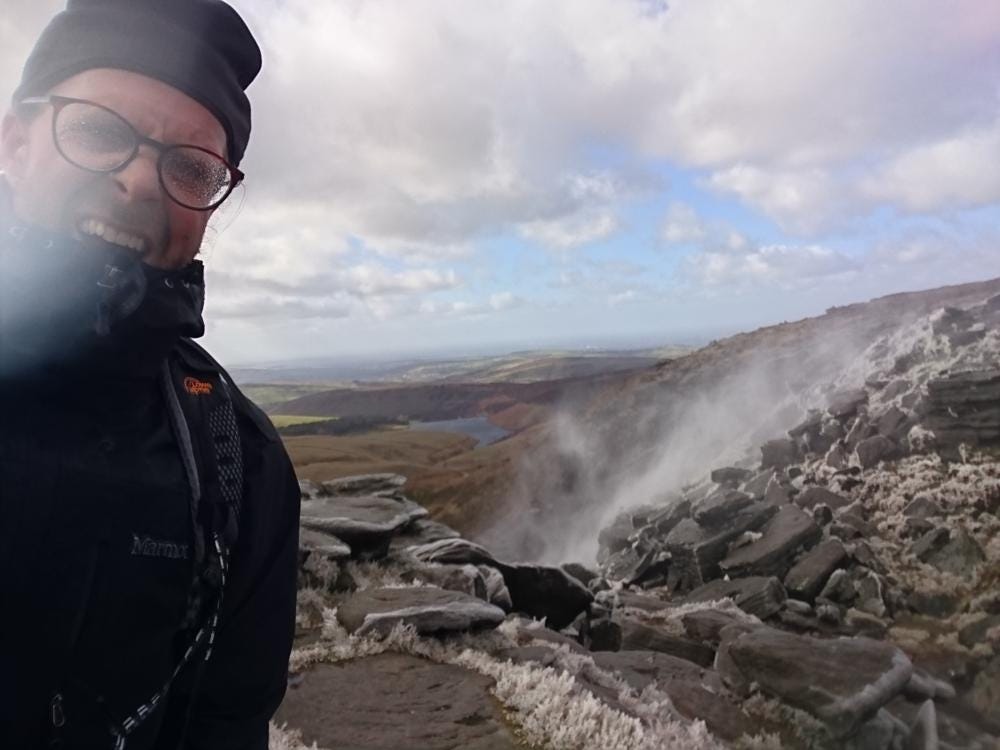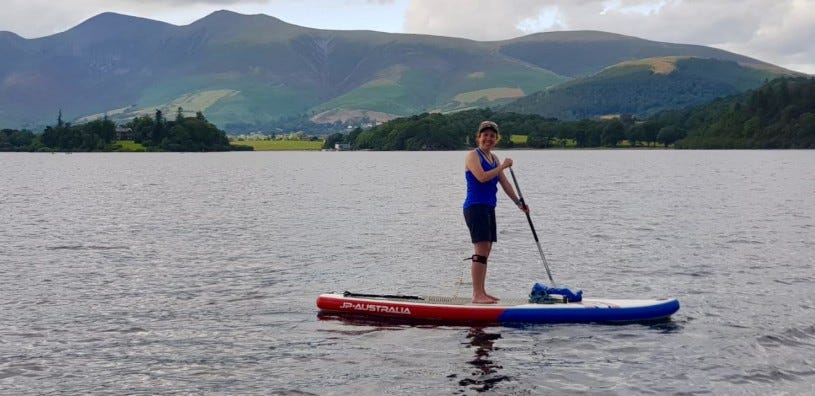Happy Friday!
Hello and welcome to Friday the 13th. The news is pretty horrifying, so why not read this instead? I can’t promise a vaccine, but I can promise an antidote: the outdoors.

Photo teaser: How can you tell north when you’re looking at a tree? Answer at the bottom…
What’s the point in bushcraft?
Last Saturday night, on Day 2 of a weekend bushcraft course, I slept in a shelter that I’d built out of dead branches, pine fronds and compacted leaf litter. As you can see, it was cosy…
When I woke up after my eight hours to a bright sunrise, I was actually a little disappointed that my shelter-building skills hadn't been tested by the heavy rain we’d been promised overnight.
I don’t know if you remember the storm last Saturday night, but it turns out that, contrary to intense scepticism, our instructors were correct: compacted leaf litter is not only solidly stormproof, but soundproof too.
A fine skill learned, but I couldn’t help reflecting that this bushcraft course would have been laughable a hundred or so years ago.
As we threw ourselves pell-mell into foraging, fire-setting and shelter-building, the instructors asked us questions like, ‘Have you made bread at home before?’, ‘Do you know how to find the North Star?’, ‘What’s a good firewood?’ and ‘Who knows how to gut a trout?’
We weren’t a particularly naive group, but all these question were met with shrugs — not unanimous shrugs, perhaps, but certainly majority shrugs.
Surely these questions would have been batted off by our ancestors, laughed at by those who preceded us by a generation or two.
~
That said, you could make a case that none of the things we learnt on the weekend are much use in the modern age.
Who needs to know how to filter water through a thick-weave cotton shirt when it comes clean from the taps?
Who needs to know how to gather dry firewood in winter when we have central heating or can buy fuelwood from the local garage?
Who needs to know the waterproofing qualities of leaf litter when we have four walls and a roof — or, at the very least, a tent?
And yet everyone on the course — even the young woman whose main priority was to protect her impressive acrylic nail art — found a weekend in the woods somehow nourishing, in spite, or perhaps because of its primitivism.
~
So what is it that makes learning bushcraft skills valuable, even today?
I think the answer can be summed up in a single word: competence.
It’s not necessarily the case that I’ll use my newly-won knowledge of natural shelter-building ever again, but there’s something reassuring about knowing that I know.
Competence breeds self-confidence, self-efficacy and self-assurance — all soft skills transferable to the rest of our lives.
Can you find your way out of a pickle?
Can you fix things that are broken?
Can you survive?
One of the mantras of the instructors was, ‘In a survival situation...’. They invited us to imagine a catastrophe that left us all alone in the wilderness, with only our wits to feed, clothe and shelter us. (The phrase was usually followed by the description of something highly illegal in the UK.)
But I am not a prepper. I have no interest in building these skills for self-preservation. I only want to become a competent member of the tribe. Someone who can be relied on when needed. Someone who can help others become stormproof.
~
Being outdoors can look a lot like being for oneself, in isolation. But, for me, being outdoors is being for others. I would not be interested in learning these skills if not to share them with, and use them for others.
I’m lucky that I have an outlet or two for the skills that I’m learning. Over the past couple of years, and almost by accident, I’ve become an outdoor leader.
This summer I’ll be part of a team helping 60 cyclists travel some of Europe’s wildest corners, camping all the way.
Last year’s adventures on Thighs of Steel were quite possibly the greatest outdoors experience of my life thus far. Not because of being for myself, in isolation, but because of being for others.
Earlier this week, I got my first ever contract for outdoor instructing, working for a small company that delivers DofE expeditions for schools.
I’ll be part of a team that introduces dozens of children to the outdoors, perhaps for the first time. My competence is central to the success of the programme and I take pride in that responsibility.
~
One of my fellow students on the bushcraft course, an affable retired police officer, loves the outdoors. Beside the fire every night, he told stories of wild fishing in the icy lakes of Snowdonia, his eyes flickering in the flamelight.
He’d caught the outdoors bug as a schoolboy fifty years earlier: on his DofE expedition. These journeys can last a lifetime.
My own appreciation of the outdoors can be traced back to Christmas and Easter family holidays to the Lake District, the Brecon Beacons or the Yorkshire Dales.
My memories are of splashing through trickling, gushing, freshet becks, hopping from stone to stone, and scoffing Kendal Mint Cake.
I’m writing to you from Edale, in the Peak District. Yesterday I walked up Kinder Scout to see the boulders of the Wool Pack and the ice fields of Kinder Downfall, but the origin of this walk can be traced back to before I was born.
In the early seventies, my dad came here after handing in his PhD thesis: relief that it was over, looking forward to a year of adventure, travelling overland to Australia with his young wife.
My mum has even older history here: a photograph of her on Mam Tor in the sixties, feeling the same breeze that whips my hair from my scalp, decades later.
The outdoors is being for others.
~
I went on the Woodland Ways bushcraft weekend. It’s full on, with hardly a moment not learning something. Highly recommended.
I caught the train from Bournemouth to Edale, changing at Manchester Picadilly. I’m staying at the Edale YHA for £13.50 a night and I had the place to myself last night.
Contrast my feeble shelter building with Dominic Van Allen, who built a concrete bunker sunk into the woods of Hampstead Heath. Thanks to T.D. for sending me this article.
A Kinder wind

The wind on Kinder is a sensory deprivation chamber.
The rattling, booming noise cuts out my sound sense; I can’t hear the tread of my feet in the bog above the screaming of my rain jacket and the howling of the withered grass.
My vision comes woozy from the wind: walking the path is like standing on the prow of a ship, eyes contending with a force that won’t be seen.
Proprioception is meaningless, my feet can only guess and hope where they might land next. Balance goes too, as moment to moment my ear canals rush with gusts and lulls.
The wind whips away my breath, making hard going over easy ground. Smells only come from the southwest, and much too quickly to distinguish anything of use.
Rushing up from the valley, the rain hits from below. I veer off course, staggering from one path to another until I reach a cluster of boulders, offering each other shelter since the last ice age, resisting the wind — and losing.
The Next Challenge grant winners

For the past few years, I’ve contributed to The Next Challenge grant to help ordinary folks go on extraordinary adventures. The grant is run by adventurer and accountant Tim Moss and every year I’m flabberghasted by the audacity of the dozen or so winners.
People like Katie Marston, a swimming teacher from Cumbria, who is using the grant to embark on a ‘leave no trace’ adventure: paddleboarding across nine lakes and hiking the land between.
The grant is an annual reminder that everyone’s adventure is just over the threshold.
On which note: Alastair Humphreys recently started a newsletter that’s got me very excited. The Working Adventurer is his attempt to answer your — our questions.
In the first edition — ‘What on earth is an adventurer and why should anyone care?’ — Al is typically honest about his vision for the newsletter:
I’m uncertain, for now, quite what direction all this all might go — that depends on the questions you ask. But in the same way that curiosity, serendipity, momentum and adventure show up once you dare yourself to get out of the front door and have a look around, I decided to just get started and give this a go.
Exactly.
Subscribe to The Working Adventurer here; ask Al a question here.
Your neck of the woods?
I’ve got another couple of days in the Peak District, then I’m back down south for some pretty intensive work, writing about forests in Central America.
I hope you find your outdoors this weekend.
Much love,
dc:
CREDITS
David Charles wrote this newsletter. He publishes another newsletter about reading called Books Make Books. David is co-writer of BBC Radio Wales sitcom Foiled, and writes for The Bike Project, Forests News, Global Landscape Forum, Elevate and Thighs of Steel. He also edits books about adventure, activism and more. Reply to this email, or delve into the archive on davidcharles.info. Thank you for reading!
Unlock the commons for £30
These free weekly newsletters are currently 0.8 percent funded. You can unlock the commons for everyone by becoming a paying subscriber for £30 a year. Thank you.
Photo teaser answer: Tree growth favours the sunny side, which in most cases in the UK is to the south. If you find a tree growing solo, then the branches will make a sort of a tick shape: on the south side the branches will grow out at 90 degrees from the trunk, whereas on the north side of the tree the branches will grow out and then up in order to reach around to capture the sun’s rays.
Careful, though: trees in clusters won’t always point south because of the way the light falls. Always take a sample of clues before committing to a direction.
Another cool trick for the treeless windswept moors that I’m walking at the moment is to look at the grass: it’ll often be permanently crooked to the northeast by the southwesterly prevailing wind.

